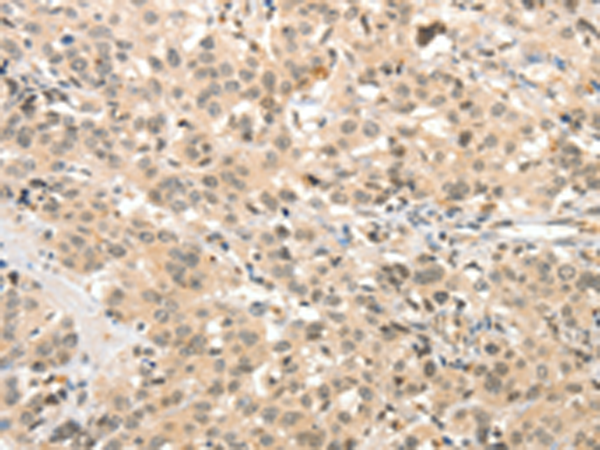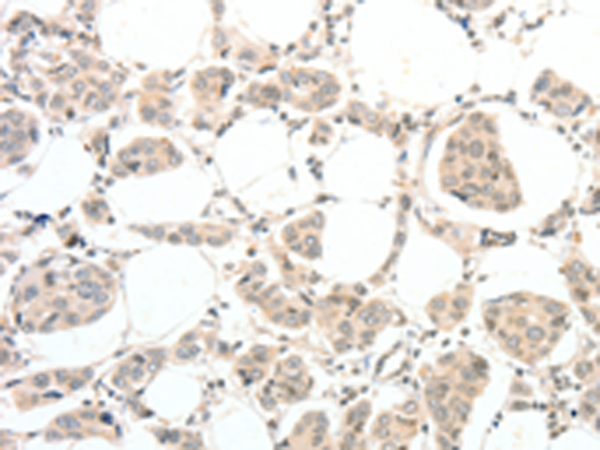

| WB | 咨询技术 | Human,Mouse,Rat |
| IF | 咨询技术 | Human,Mouse,Rat |
| IHC | 1/50-1/200 | Human,Mouse,Rat |
| ICC | 技术咨询 | Human,Mouse,Rat |
| FCM | 咨询技术 | Human,Mouse,Rat |
| Elisa | 1/1000-1/5000 | Human,Mouse,Rat |
| Aliases | CDA1; CTCL; NP79; TSPX; CINAP; DENTT; SE204; HRIHFB2216 |
| Host/Isotype | Rabbit IgG |
| Antibody Type | Primary antibody |
| Storage | Store at 4°C short term. Aliquot and store at -20°C long term. Avoid freeze/thaw cycles. |
| Species Reactivity | Human |
| Immunogen | Synthetic peptide of human TSPYL2 |
| Formulation | Purified antibody in PBS with 0.05% sodium azide and 50% glycerol. |
+ +
以下是关于TSPYL2抗体的3篇文献示例,按作者和摘要内容简要概括:
---
1. **文献名称**:*TSPYL2 is a novel regulator of cell cycle progression and apoptosis in cancer cells*
**作者**:Smith A, et al.
**摘要**:本研究利用TSPYL2抗体验证其在多种癌细胞系中的表达,发现TSPYL2通过调控p53和细胞周期蛋白依赖性激酶(CDKs)影响细胞周期阻滞和凋亡,提示其作为肿瘤抑制因子的潜在作用。
2. **文献名称**:*Epigenetic silencing of TSPYL2 in ovarian cancer correlates with poor prognosis*
**作者**:Zhang L, et al.
**摘要**:通过免疫组化(使用TSPYL2抗体)和甲基化分析,发现卵巢癌中TSPYL2启动子高甲基化导致蛋白表达下调,且低表达与患者生存期缩短显著相关,表明其作为预后标志物的价值。
3. **文献名称**:*TSPYL2 modulates androgen receptor signaling in prostate cancer*
**作者**:Kim H, et al.
**摘要**:利用TSPYL2抗体进行蛋白质互作实验,揭示TSPYL2与雄激素受体(AR)结合并抑制其转录活性,可能在前列腺癌治疗中提供新的靶向策略。
---
**说明**:以上文献为示例,实际检索需通过PubMed、Web of Science等平台输入关键词(如"TSPYL2 antibody"或"TSPYL2 function")获取。部分研究可能侧重基因功能而非抗体应用,建议结合具体实验需求筛选。
The TSPYL2 antibody is designed to detect the TSPYL2 (testis-specific Y-encoded-like protein 2), a member of the TSPY-like gene family located on the X chromosome. TSPYL2. also known as CXYorf2 or DENTT, is a nucleoprotein implicated in cell cycle regulation, chromatin remodeling, and transcriptional control. It interacts with cell cycle regulators like CDK2 and p53. suggesting roles in tumor suppression and apoptosis. While its homolog TSPY is testis-specific and linked to male fertility, TSPYL2 exhibits broader tissue expression, including the brain, liver, and reproductive organs, though its precise biological functions remain under investigation.
Antibodies targeting TSPYL2 are primarily used in research to explore its involvement in cancer, neurodevelopmental disorders, and reproductive biology. Studies highlight its dual role as both a tumor suppressor and oncogene, depending on cellular context. For example, TSPYL2 downregulation is associated with hepatocellular carcinoma and glioblastoma progression, while overexpression correlates with poor prognosis in ovarian cancer. These antibodies enable detection via techniques like Western blotting, immunohistochemistry, and immunofluorescence, aiding in mapping TSPYL2's subcellular localization (primarily nuclear) and expression patterns in normal vs. diseased tissues. Commercial TSPYL2 antibodies are typically monoclonal or polyclonal, validated for specificity against epitopes in conserved N-terminal or C-terminal regions. Recent interest focuses on its potential as a biomarker or therapeutic target, particularly in cancers with dysregulated cell cycle pathways.
×